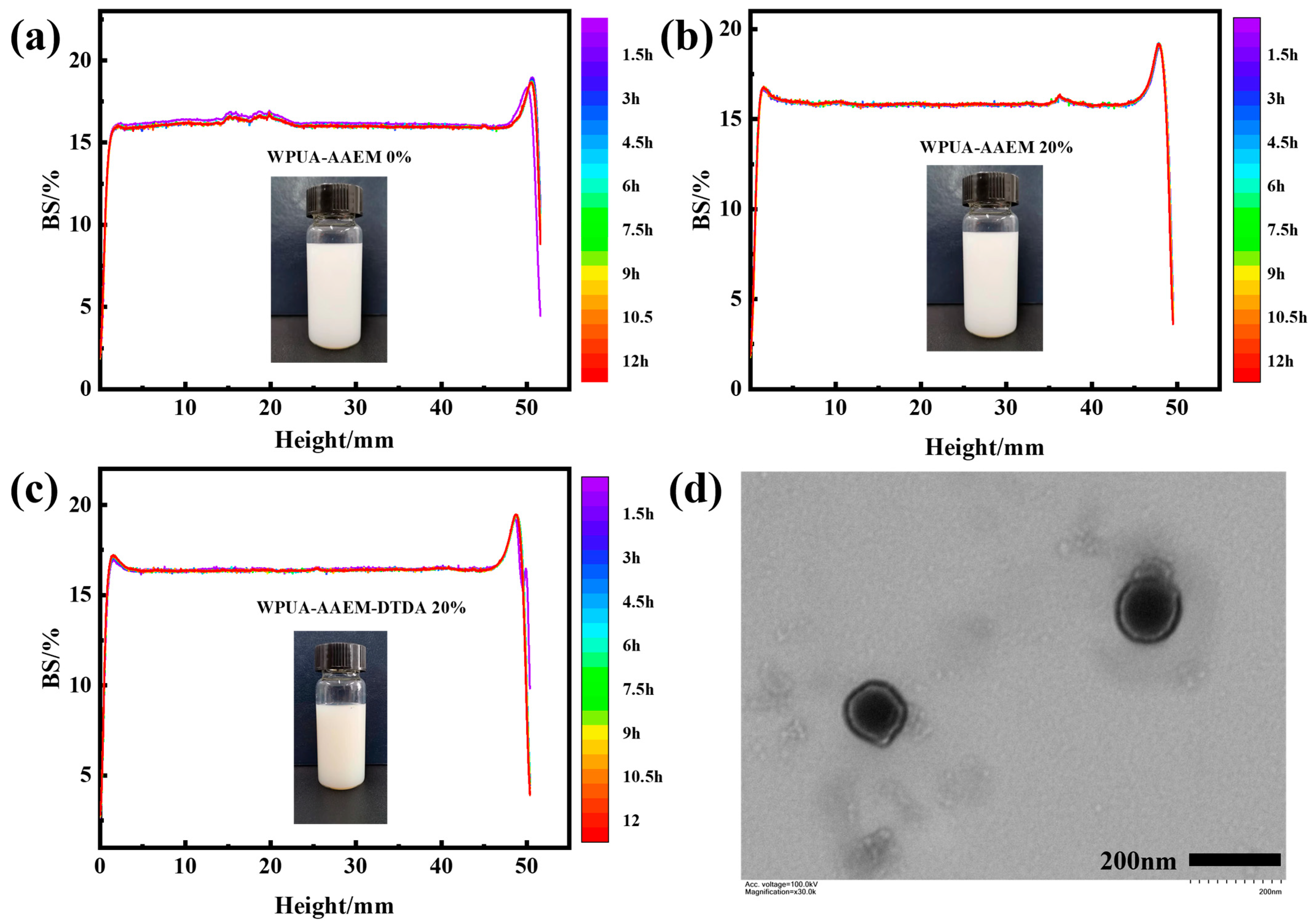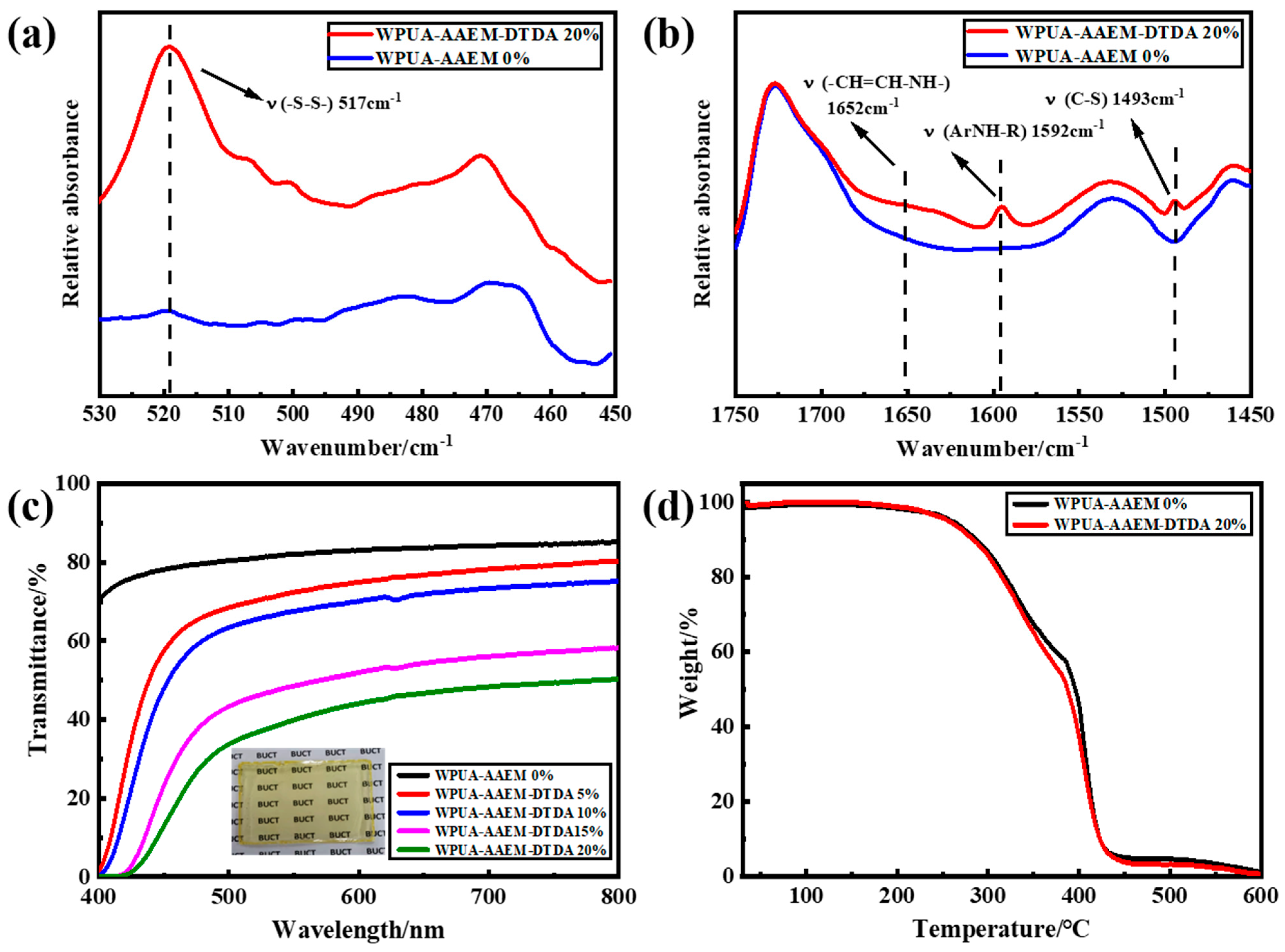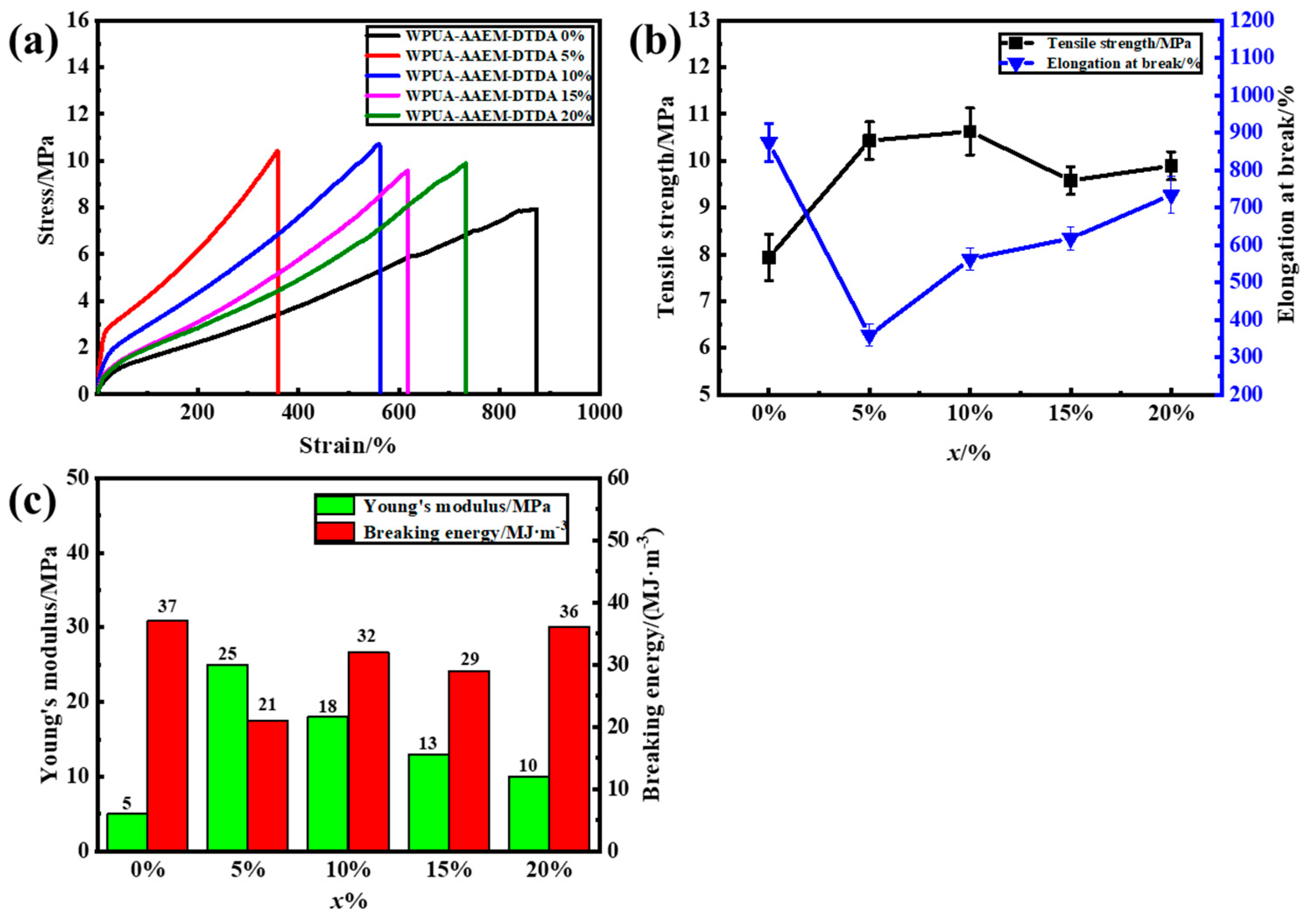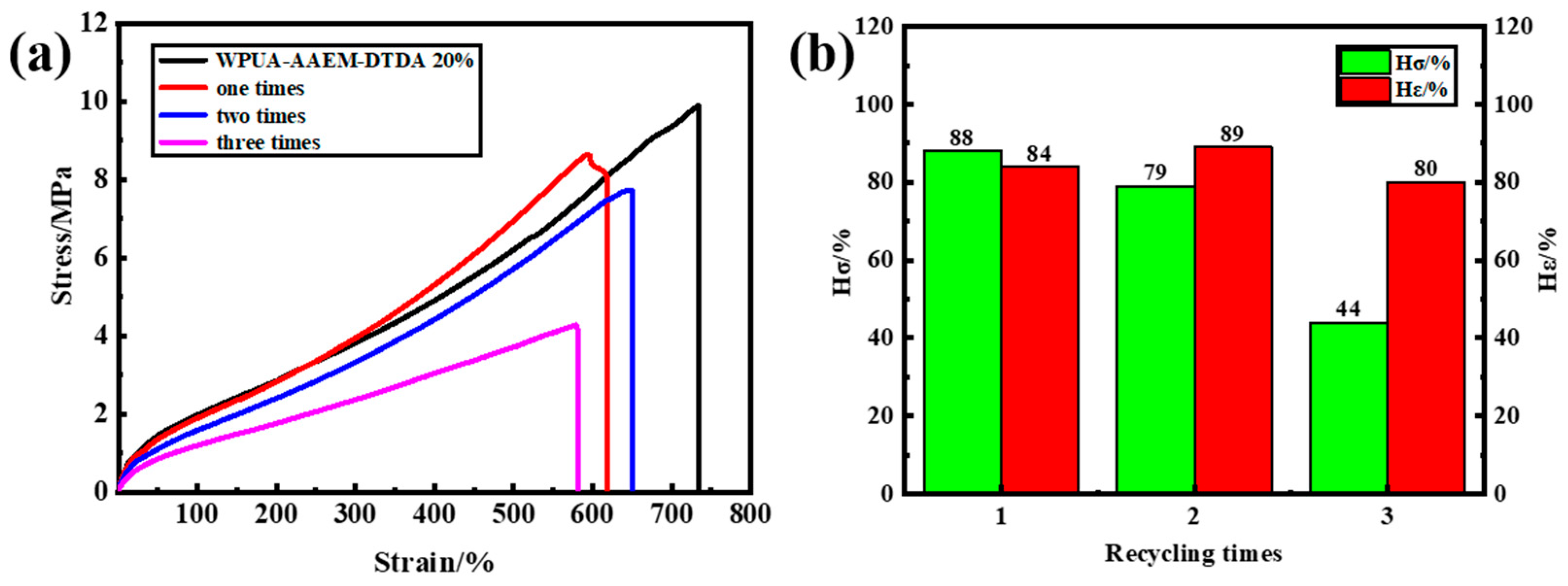The Post-Curing of Waterborne Polyurethane–Acrylate Composite Latex with the Dynamic Disulfide-Bearing Crosslinking Agent
Abstract
:1. Introduction
2. Results and Discussion
2.1. Synthesis of WPUA–AAEM Latex
2.2. The Film Formation and Curing
2.3. The Mechanical Properties, Self-Healing and Reprocessing
3. Materials and Methods
3.1. Materials
3.2. Characterization
3.3. Synthesis of WPUA Composite Latex
3.4. Film Formation and Post-Curing
3.5. The Self-Healing and Reprocessing
4. Conclusions
Supplementary Materials
Author Contributions
Funding
Institutional Review Board Statement
Informed Consent Statement
Data Availability Statement
Conflicts of Interest
References
- Scheutz, G.; Lessard, J.; Sims, M.; Sumerlin, B. Adaptable Crosslinks in Polymeric Materials: Resolving the Intersection of Thermoplastics and Thermosets. J. Am. Chem. Soc. 2019, 141, 16181–16196. [Google Scholar] [CrossRef] [PubMed]
- Chen, Y.; Yang, L.; Zheng, W.; Ouyang, P.; Zhang, H.; Ruan, Y.; Weng, W.; He, X.; Xia, H. Dynamic Polymer Network System Mediated by Radically Exchangeable Covalent Bond and Carbolong Complex. ACS Macro. Lett. 2020, 9, 344–349. [Google Scholar] [CrossRef] [PubMed]
- Zhang, Y.; Ying, H.; Hart, K.; Wu, Y.; Hsu, A.; Coppola, A.; Kim, T.; Yang, K.; Sottos, N.; White, S.; et al. Malleable and Recyclable Poly(urea-urethane) Thermosets bearing Hindered Urea Bonds. Adv. Mater. 2016, 28, 7646–7651. [Google Scholar] [CrossRef] [PubMed]
- Zhang, L.; Rowan, S. Effect of sterics and degree of cross-linking on the mechanical properties of dynamic poly(alkylurea-urethane) networks. Macromolecules 2017, 50, 5051–5060. [Google Scholar] [CrossRef]
- Guo, Z.; Bao, C.; Wang, X.; Lu, X.; Sun, H.; Li, X.; Li, J.; Sun, J. Room-temperature healable, recyclable and mechanically super-strong poly(urea-urethane)s cross-linked with nitrogen-coordinated boroxines. J. Mater. Chem. A 2021, 9, 11025–11032. [Google Scholar] [CrossRef]
- Choi, S.; Kim, J.; Seo, E.; Jung, H.; Jeong, J.; Park, Y.; Kim, J.; Lee, D.; Kim, B.; Lee, S. Dual crosslinking polymer networks: Correlation between polymer topologies and self-healing efficiency. Polym. Chem. 2023, 14, 1184–1194. [Google Scholar] [CrossRef]
- Röttger, M.; Domenech, T.; van der Weegen, R.; Breuillac, A.; Nicolaÿ, R.; Leibler, L. High-performance vitrimers from commodity thermoplastics through dioxaborolane metathesis. Science 2017, 356, 62–65. [Google Scholar] [CrossRef]
- Demongeot, A.; Groote, R.; Goossens, H.; Hoeks, T.; Tournilhac, F.; Leibler, L. Cross-linking of poly (butylene terephthalate) by reactive extrusion using Zn(II) epoxy-vitrimer chemistry. Macromolecules 2017, 50, 6117–6127. [Google Scholar] [CrossRef]
- Montarnal, D.; Capelot, M.; Tournilhac, F.; Leibler, L. Silica-like malleable materials from permanent organic networks. Science 2011, 334, 965–968. [Google Scholar] [CrossRef]
- Taynton, P.; Yu, K.; Shoemaker, R.; Jin, Y.; Qi, H.; Zhang, W. Heat- or water-driven malleability in a highly recyclable covalent network polymer. Adv. Mater. 2014, 26, 3938–3942. [Google Scholar] [CrossRef]
- Zhao, S.; Abu-Omar, M. Recyclable and malleable epoxy thermoset bearing aromatic imine bonds. Macromolecules 2018, 51, 9816–9824. [Google Scholar] [CrossRef]
- Sun, H.; Kabb, C.; Dai, Y.; Hill, M.; Ghiviriga, I.; Bapat, A.; Sumerlin, B. Macromolecular metamorphosis via stimulus-induced transformations of polymer architecture. Nat. Chem. 2017, 9, 817–823. [Google Scholar] [CrossRef] [PubMed]
- Rivero, G.; Nguyen, L.; Hillewaere, X.; Du Prez, F. One-Pot Thermo-Remendable Shape Memory Polyurethanes. Macromolecules 2014, 47, 2010–2018. [Google Scholar] [CrossRef]
- Nishimura, Y.; Chung, J.; Muradyan, H.; Guan, Z. Silyl Ether as a robust and thermally stable dynamic covalent motif for malleable polymer design. J. Am. Chem. Soc. 2017, 139, 14881–14884. [Google Scholar] [CrossRef] [PubMed]
- Wu, X.; Yang, X.; Yu, R.; Zhao, X.; Zhang, Y.; Huang, W. A facile access to stiff epoxy vitrimers with excellent mechanical properties via siloxane equilibration. J. Mater. Chem. A 2018, 6, 10184–10188. [Google Scholar] [CrossRef]
- Pepels, M.; Filot, I.; Klumperman, B.; Goossens, H. Self-healing systems based on disulfide-thiol exchange reactions. Polym. Chem. 2013, 4, 4955. [Google Scholar] [CrossRef]
- Michal, B.; Jaye, C.; Spencer, E.; Rowan, S. Inherently Photohealable and Thermal Shape-Memory Polydisulfide Networks. ACS. Macro. Lett. 2013, 2, 694–699. [Google Scholar] [CrossRef] [PubMed]
- Takahashi, A.; Goseki, R.; Otsuka, H. Frontispiece: Thermally Adjustable Dynamic Disulfide Linkages Mediated by Highly Air-Stable 2,2,6,6-Tetramethylpiperidine-1-sulfanyl (TEMPS) Radicals. Angew. Chem. Int. Ed. 2017, 56, 2016–2021. [Google Scholar] [CrossRef]
- Griebel, J.; Nguyen, N.; Astashkin, A.; Glass, R.; Mackay, M.; Char, K.; Pyun, J. Preparation of Dynamic Covalent Polymers via Inverse Vulcanization of Elemental Sulfur. ACS Macro. Lett. 2014, 3, 1258–1261. [Google Scholar] [CrossRef]
- Lu, Y.; Guan, Z. Olefin metathesis for effective polymer healing via dynamic exchange of strong carbon-carbon double bonds. J. Am. Chem. Soc. 2012, 134, 14226–14231. [Google Scholar] [CrossRef]
- Lu, Y.; Tournilhac, F.; Leibler, L.; Guan, Z. Making insoluble polymer networks malleable via olefin metathesis. J. Am. Chem. Soc. 2012, 134, 8424–8427. [Google Scholar] [CrossRef] [PubMed]
- Webber, M.; Tibbitt, M. Dynamic and reconfigurable materials from reversible network interactions. Nat. Rev. Mater. 2022, 7, 541–556. [Google Scholar] [CrossRef]
- Shi, J.; Zheng, T.; Zhang, Y.; Guo, B.; Xu, J. Reprocessable Crosslinked Polyurethane with Dynamic and Tunable Phenol-Carbamate Network. ACS Sustain. Chem. Eng. 2020, 8, 1207–1218. [Google Scholar] [CrossRef]
- Zhu, J.; Li, J.; Sang, C.; Luo, Y. Synthesis of polymeric dyes based on waterborne polyurethane: Reaction kinetics study using UV absorption spectroscopy. New J. Chem. 2020, 44, 2930–2940. [Google Scholar] [CrossRef]
- Liu, H.; Hu, T.; Wang, D.; Shi, J.; Zhang, J.; Wang, J.; Pu, Y.; Chen, J. Preparation of fluorescent waterborne polyurethane nanodispersion by high-gravity miniemulsion polymerization for multifunctional applications. Chem. Eng. Process. 2019, 136, 36–43. [Google Scholar] [CrossRef]
- Sijbesma, R.; Beijer, F.; Brunsveld, L.; Folmer, B.; Hirschberg, J.; Lange, R.; Lowe, J.; Meijer, E. Reversible polymers formed from self-complementary monomers using quadruple hydrogen bonding. Science 1997, 278, 1601–1604. [Google Scholar] [CrossRef] [PubMed]
- Yanagisawa, Y.; Nan, Y.; Okuro, K.; Aida, T. Mechanically robust, readily repairable polymers via tailored noncovalent cross-linking. Science 2018, 359, 72–76. [Google Scholar] [CrossRef]
- Tennebroek, R.; van der Hoeven-van Casteren, I.; Swaans, R.; van der Slot, S.; Stals, P.; Tuijtelaars, B.; Koning, C. Water-based polyurethane dispersions. Polym. Int. 2019, 68, 832–842. [Google Scholar] [CrossRef]
- Qiu, F.; Zhang, J.; Wu, D.; Yang, D. Waterborne polyurethane and modified polyurethane acrylate composites. Plast. Rubber Compos. 2010, 39, 454–459. [Google Scholar] [CrossRef]
- Peruzzo, P.; Anbinder, P.; Pardini, O.; Vega, J.; Costa, C.; Galembeck, F.; Amalvy, J. Waterborne polyurethane/acrylate: Comparison of hybrid and blend systems. Prog. Org. Coat. 2011, 72, 429–437. [Google Scholar] [CrossRef]
- Nevejans, S.; Ballard, N.; Rivilla, I.; Fernández, M.; Santamaria, A.; Reck, B.; Asua, J. Synthesis of mechanically strong waterborne poly(urethane-urea)s capable of self-healing at elevated temperatures. Eur. Polym. J. 2019, 112, 411–422. [Google Scholar] [CrossRef]
- Wu, X.; Liu, M.; Zhong, J.; Zhong, Y.; Rong, J.; Gao, F.; Qiao, Y.; Shen, L.; He, H. Self-healing dynamic bond-based robust polyurethane acrylate hybrid polymers. New J. Chem. 2022, 46, 13415–13421. [Google Scholar] [CrossRef]
- Mehravar, S.; Ballard, N.; Tomovska, R.; Asua, J. Polyurethane (PU)/acrylic hybrid waterborne dispersions: Synthesis, properties and applications. Ind. Eng. Chem. Res. 2019, 58, 20902–20922. [Google Scholar] [CrossRef]
- Maurya, S.; Kurmvanshi, S.; Mohanty, S.; Nayak, S. A Review on Acrylate-Terminated Urethane Oligomers and Polymers: Synthesis and Applications. Polym. Plast. Technol. Eng. 2017, 57, 625–656. [Google Scholar] [CrossRef]
- An, Z.; Xue, R.; Ye, K.; Zhao, H.; Liu, Y.; Li, P.; Chen, Z.; Huang, C.; Hu, G. Recent advances in self-healing polyurethane based on dynamic covalent bonds combined with other self-healing methods. Nanoscale 2023, 15, 6505–6520. [Google Scholar] [CrossRef] [PubMed]
- Wang, W.; Peng, R.; Gao, Y.; Nie, J.; Sun, F. Synthesis and Property of an Organosilicon Polyurethane Acrylate Prepolymer Containing Disulfide Bonds for Photopolymerization. Macromol. Chem. Phys. 2023, 60, 375–383. [Google Scholar] [CrossRef]
- Zhang, Y.; Sheng, Y.; Wang, M.; Lu, X. UV-curable self-healing, high hardness and transparent polyurethane acrylate coating based on dynamic bonds and modified nano-silica. Prog. Org. Coat. 2022, 172, 107051. [Google Scholar] [CrossRef]
- Gao, S.; Ma, G.; Ye, J.; He, L.; Guo, L.; Li, X.; Qiu, T.; Tuo, X. The tough, fluorescent and adhesive elastomer in aqueous dispersion: The contribution of aromatic amide-urea segments. Mater. Today Commun. 2021, 29, 2352–4928. [Google Scholar] [CrossRef]
- Nellepalli, P.; Patel, T.; Oh, J. Dynamic Covalent Polyurethane Network Materials: Synthesis and Self-Healability. Macromol. Rapid. Commun. 2021, 42, 2100391. [Google Scholar] [CrossRef]
- Elling, B.; Dichtel, W. Reprocessable Cross-Linked Polymer Networks: Are Associative Exchange Mechanisms Desirable? ACS Cent. Sci. 2020, 6, 1488–1496. [Google Scholar] [CrossRef]
- Gong, T.; Guo, L.; Ye, J.; He, L.; Qiu, T.; Li, X. A post curing strategy toward the feasible covalent adaptable networks in polyacrylate latex films. J. Polym. Sci. 2021, 59, 1807–1820. [Google Scholar] [CrossRef]
- Deng, Y.; Zhou, C.; Zhang, M.; Zhang, H. Effects of the reagent ratio on the properties of waterborne polyurethanes-acrylate for application in damping coating. Prog. Org. Coat. 2018, 122, 239–247. [Google Scholar] [CrossRef]
- GB/T 1040. GB/T 1040.3-2006; Plastics—Determination of Tensile Properties—Part 3: Test Conditions for Films and Sheets. National Standard of the People’s Republic of China: Beijing, China, 2006.







| AAEM Content (x) | Conv. % | Particle Size/(d·nm) | PDI | Centrifugation Stability * | Storage Stability ** |
|---|---|---|---|---|---|
| 0% | 98% | 90 | 0.299 | Passed | ≥6 months |
| 5% | 98% | 105 | 0.194 | Passed | ≥6 months |
| 10% | 97% | 114 | 0.242 | Passed | ≥6 months |
| 15% | 96% | 138 | 0.368 | Passed | ≥6 months |
| 20% | 97% | 144 | 0.294 | Passed | ≥6 months |
Disclaimer/Publisher’s Note: The statements, opinions and data contained in all publications are solely those of the individual author(s) and contributor(s) and not of MDPI and/or the editor(s). MDPI and/or the editor(s) disclaim responsibility for any injury to people or property resulting from any ideas, methods, instructions or products referred to in the content. |
© 2023 by the authors. Licensee MDPI, Basel, Switzerland. This article is an open access article distributed under the terms and conditions of the Creative Commons Attribution (CC BY) license (https://creativecommons.org/licenses/by/4.0/).
Share and Cite
Zhang, H.; Liang, R.; Wang, Q.; Luan, W.; Ye, J.; Qiu, T.; Tuo, X. The Post-Curing of Waterborne Polyurethane–Acrylate Composite Latex with the Dynamic Disulfide-Bearing Crosslinking Agent. Molecules 2023, 28, 8122. https://doi.org/10.3390/molecules28248122
Zhang H, Liang R, Wang Q, Luan W, Ye J, Qiu T, Tuo X. The Post-Curing of Waterborne Polyurethane–Acrylate Composite Latex with the Dynamic Disulfide-Bearing Crosslinking Agent. Molecules. 2023; 28(24):8122. https://doi.org/10.3390/molecules28248122
Chicago/Turabian StyleZhang, Haotian, Rihui Liang, Qianshu Wang, Wenbo Luan, Jun Ye, Teng Qiu, and Xinlin Tuo. 2023. "The Post-Curing of Waterborne Polyurethane–Acrylate Composite Latex with the Dynamic Disulfide-Bearing Crosslinking Agent" Molecules 28, no. 24: 8122. https://doi.org/10.3390/molecules28248122
APA StyleZhang, H., Liang, R., Wang, Q., Luan, W., Ye, J., Qiu, T., & Tuo, X. (2023). The Post-Curing of Waterborne Polyurethane–Acrylate Composite Latex with the Dynamic Disulfide-Bearing Crosslinking Agent. Molecules, 28(24), 8122. https://doi.org/10.3390/molecules28248122





